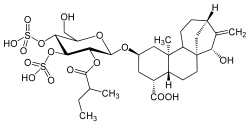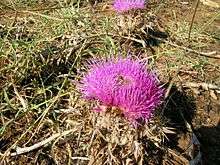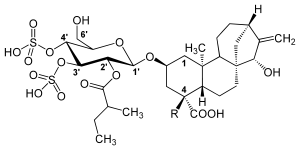Atractyloside
 Structure formula of atractyloside | |
| Names | |
|---|---|
Other names
| |
| Identifiers | |
| ECHA InfoCard | 100.162.426 |
| PubChem CID |
|
| Properties | |
| C30H46O16S2 | |
| Molar mass | 726,81 g·mol−1 |
| Except where otherwise noted, data are given for materials in their standard state (at 25 °C [77 °F], 100 kPa). | |
| Infobox references | |
Atractyloside (ATR) is a natural, toxic glycoside and an effective ADP/ATP translocase inhibitor.
Occurrence

Atractyloside is synthesized by some plant species e.g. the distaff thistle (Atractylis gummifera) from the Asteraceae family. Further plants, also from the family of the Asteraceae, are the species: Callilepis laureola, Xanthium strumarium, Iphiona alsoeri, and Pascalia glauca.
History
The poisonous effect of the distaff thistle (due to atractyloside) is documented in history. The plant growing in the Mediterranean region was therefore often used for suicide or murder. Examples of accidental poisoning are documented in Italy and Algeria in 1955 and 1975 respectively, where children have eaten parts of the plant.[1][2]
Although Ed Lefranc has isolated Atractyloside in 1868 from Atractylis gummifera,[3] the structure was identified only 100 years later.[4]
Properties

Atractyloside is a hydrophilic glycoside. A modified glucose is linked to the hydrophobic diterpene atractyligenin by a β1-glycosidic bond. A carboxyl group is positioned at the C4 position in the axial position. The glucose part is esterified with isovaleric acid on the C2' atom, and sulfuric acid on the C3' and C4' atoms. By hydrolysis a molecule of D-(+)-Glucose, isovaleric acid. atractyligenin, and two molecules of sulfuric acid could be obtained. The two sulfate groups and the carboxyl group in ATR are in a deprotonated form under physiological conditions. Thus, ATR is triple negatively charged.
A modified variant of the atractylenolide carries an additional carboxyl group at the C4 atom of the atractyligenin, which is then referred to as carboxy-atractyloside (CATR), sometimes referred to as "Gummiferin".[5][6]
Pharmacological properties
In biochemical studies of mitochondria, the effect of atractyloside on the ADP/ATP transport was recognized even before the actual transporter was identified. ATR or CATR bind to the ADP/ATP translocase, which is located on the inner mitochondrial membrane. ATR binds competitively to the translocase competitive up to a concentration of 5 mmol while CATR binds in a non-competitive manner. As a result, the exchange of ADP and ATP is no longer carried out and the cell dies due to lack of energy.
The chemical structure and charge distribution of atractyloside is similar to that of ADP: the sulfate groups correspond to the phosphate groups, the glucose part corresponds to the ribose part, and the hydrophobic atractyligenine residue corresponds to the hydrophobic purine residue of ADP.
The carboxyl group on the C4 atom of the atractyligenin is important for toxicity. If this is reduced to a hydroxyl group (atractylitriol), the substance becomes non-toxic. By a loss of the sulfate groups in ATR, this can no longer bind to the ADP/ATP translocator and thereby also loses its toxic effect.[7] On the other hand, the free hydroxy group on the C6 atom of the glucose moiety is modifiable without affecting the toxicity of ATRs.
Poisoning
The mean lethal dose in rats (i.p.) is for ATR 143 mg·kg -1, for CATR 2,9 mg·kg −1.
References
- ↑ Santi, R. und Cascio, G. (1955): Ricerche farmacologiche sul principio attivo dell' Atractylis gummifera. 1. Accione generale. In: Arch Ital Sci Farmacol. 5; 534–563.
- ↑ Lemaigre G. et al. (1975): Fulminating hepatitis caused by glue thistle (Atractylis glummifera-L.), poisoning. Anatomo-pathological study of 4 cases. In: Nouv Presse Med. 4(40); 2565–2568; PMID 1215192.
- ↑ Lefranc, E. (1868): Sur l’acide atractylique et les atractylates, produits immédiats de la racine de l’Atractylis gummifera. In: Compt. Rend. 67; 954–961
- ↑ Piozzi F. et al. (1966): The structure and stereochemistry of atractyligenin. In: Tetrahedron 22 (Supplement 8); 515–529; doi:10.1016/S0040-4020(01)90959-7.
- ↑ Danieli, B. et al. (1972): Structure of the diterpenoid carboxyatractyloside. In: Phytochemistry 11(12); 3501–3504; doi:10.1016/S0031-9422(00)89846-5.
- ↑ Vignais, PV. et al. (1973): Adenosine diphosphate translocation in mitochondria. Nature of the receptor site for carboxyatractyloside (gummiferin). In: Biochemistry. 12(8); 1508–1519; PMID 4699983; doi:10.1021/bi00732a007.
- ↑ Vignais, PV. et al. (1966): Effects of atractyligenin and its structural analogues on oxidative phosphorylation and on the translocation of adenine nucleotides in mitochondria. In: Biochim Biophys Acta. 118(3); 465–483; PMID 4226320.